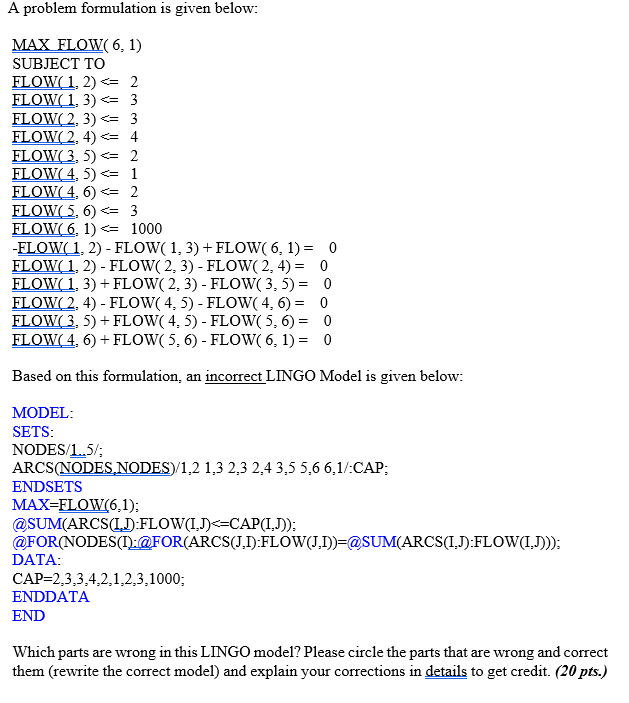Question
A problem formulation is given below MAX FLOW( 6, 1) SUBJECT TO FLOW( 1, 2) FLOW( 1, 3) FLOW( 2, 3) FLOW( 2, 4) FLOW(
A problem formulation is given below
MAX FLOW( 6, 1)
SUBJECT TO
FLOW( 1, 2)
FLOW( 1, 3)
FLOW( 2, 3)
FLOW( 2, 4)
FLOW( 3, 5)
FLOW( 4, 5)
FLOW( 4, 6)
FLOW( 5, 6)
FLOW( 6, 1)
-FLOW( 1, 2) - FLOW( 1, 3) + FLOW( 6, 1) = 0
FLOW( 1, 2) - FLOW( 2, 3) - FLOW( 2, 4) = 0
FLOW( 1, 3) + FLOW( 2, 3) - FLOW( 3, 5) = 0
FLOW( 2, 4) - FLOW( 4, 5) - FLOW( 4, 6) = 0
FLOW( 3, 5) + FLOW( 4, 5) - FLOW( 5, 6) = 0
FLOW( 4, 6) + FLOW( 5, 6) - FLOW( 6, 1) = 0
Based on this formulation, an incorrect LINGO Model is given below:
MODEL:
SETS:
NODES/1..5/;
ARCS(NODES,NODES)/1,2 1,3 2,3 2,4 3,5 5,6 6,1/:CAP;
ENDSETS
MAX=FLOW(6,1);
@SUM(ARCS(I,J):FLOW(I,J)
@FOR(NODES(I):@FOR(ARCS(J,I):FLOW(J,I))=@SUM(ARCS(I,J):FLOW(I,J)));
DATA:
CAP=2,3,3,4,2,1,2,3,1000;
ENDDATA
END
Which parts are wrong in this LINGO model? Please circle the parts that are wrong and correct them (rewrite the correct model) and explain your corrections in details to get credit.

A problem formulation is given below: MAX FLOW(6, 1) SUBJECT TO FLOW(1, 2) = 2 FLOW(1, 3)
Step by Step Solution
There are 3 Steps involved in it
Step: 1

Get Instant Access to Expert-Tailored Solutions
See step-by-step solutions with expert insights and AI powered tools for academic success
Step: 2

Step: 3

Ace Your Homework with AI
Get the answers you need in no time with our AI-driven, step-by-step assistance
Get Started


